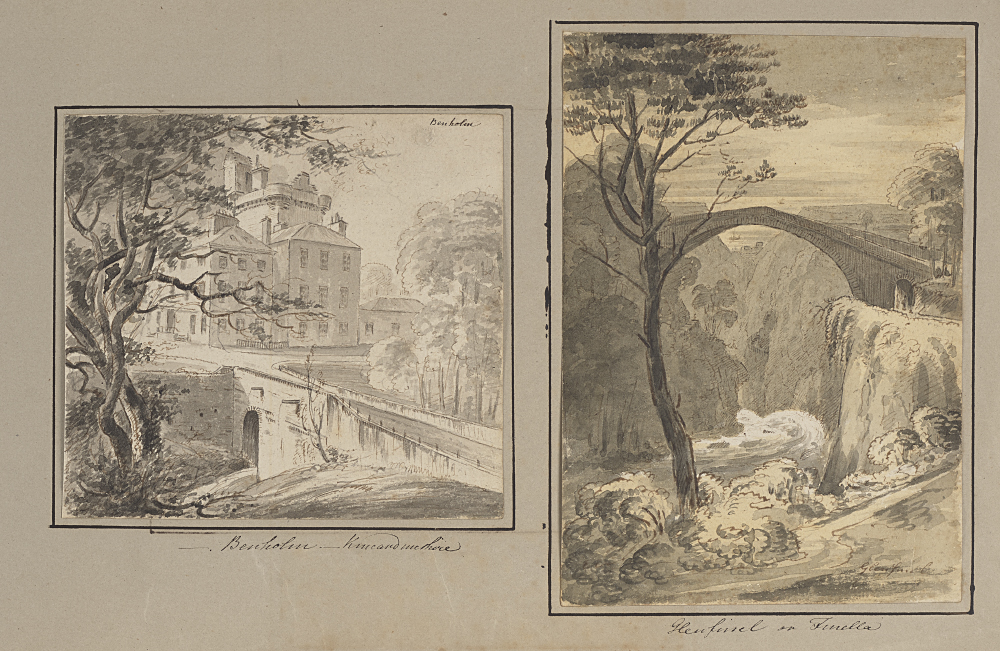
James Skene was a close friend of one of Scotland’s greatest and most influential writers. By profession he was a lawyer, but he was also a keen amateur artist. Skene and Scott first met as fellow Advocates at the Scottish Bar and were brought together by their common love of German literature. They were subsequently joint co-founders of the Light Horse Regiment and the pair formed a close friendship.
This particular album appears to have fallen into obscurity over the years, as it had been in private collections and out of public view. Skene made these sketches for Scott to use as a reference or aide-memoire when writing his novels. Knowledge of its existence does not appear in any research or exhibitions relating to Scott or Skene. We were very fortunate to have this new acquisition and it was a pleasure to personally handle this beautiful album and see every drawing up close.

Prior to the album’s arrival in the digital imaging unit it needed to be assessed by the conservation department for any damage or areas of fragility needing repairs. These included reattaching corners that were loose on the drawings, repairing the iron gall ink borderlines that had partially split around some of the drawings, reattaching any loose drawings whose original placements were clearly discernible (confirmed by an archivist), and patching any holes that had been made from the drawings coming loose.

Simple record shots were requested for the album, so to speed up the photography process it was decided the album would be shot as spreads. This presented some minor challenges because the album is in a landscape format, creating a long irregular shape when opened flat. I used a Phase One camera which I mounted high up on a copy stand, ensuring the spreads would be in the frame with additional space around for any fold-out materials exceeding the page width.
Occasionally I came across extra long fold out illustrations, however it was the smaller, double-sided fold-outs that presented some challenges. These were left unphotographed as they were glued along the top edge and it was not possible to safely photograph the undersides without damaging the original materials.

As I worked through this remarkable album I couldn’t help but admire the level of detail in these small-scale, seemingly effortless illustrations every time I turned the page. The beauty of the Scottish landscape has attracted artists for centuries due to the arresting, ethereal quality of light and changing weather patterns against dramatic backdrops of glens, lochs and castles. Without a doubt, Skene would have enjoyed his subject matter, especially with an illuminating and equally creative friend close by. You can almost imagine him standing with Scott, painting en plein air, both men inspired by the scenery as their horses rest nearby. Perhaps Scott would write the occasional note down as they discussed storylines in the Waverley novels pertaining to the locations they visited.

Of their country rides, Skene wrote:
The beauty of the scenery gave full employment to my pencil, with the free and frequent exercise of which he [Scott] never seemed to feel impatient, for he was ready and willing at all times to alight where any scene attracted our notice…

Skene expertly captures the atmospheric shifts in the landscape and historic landmarks with a few simple but expressive brushstrokes and washes of watercolour in his illustrations. Sometimes he might make a note about the location, as seen here in Glen Finella;

“Finella was daughter of the Earl of Angus. In order to revenge the loss of her son, she is reported to have murdered King Kenneth the 3rd of Scotland and flying from the castle of Kincardine in this neighbourhood to have been overtaken near this spot and put to death. The fall is 63 feet perpendicular height.”
Looking at this location today, it appears that the bridge was converted into a viaduct some time later as the distinctive bridge originally illustrated is no longer present.
The album’s cultural significance in relation to Sir Walter Scott is certainly important, but from an archival perspective, I can’t help but appreciate this time capsule of records of historic buildings and how they used to look, and comparing the illustrations to changes or losses that have occurred since then. Similar to Glen Finella, one other such example is Linlithgow Palace, missing some of the decorative crenelated tower-tops near the entrance, or were these perhaps simply added as an artistic flourish?

It’s clear that Scott and Skene had a great friendship; this album is a wonderful representation of the time they spent together documenting the scenery they saw on their travels. In his works, Scott dedicated the following excerpt to him:
Eleven years we now may tell,/ Since we have known each other well;/ Since riding side by side, our hand first drew the voluntary brand;/ and sure, through many a varied scene, unkindness never came between…
Fourth canton of Marmion, 1808
Juliette Lichman
Photographer
Be First to Comment